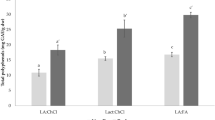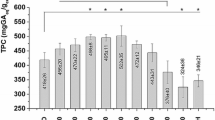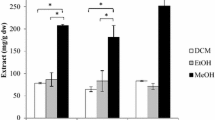Abstract
Pine bark is a byproduct of wood processing which is usually burnt for energy. This article analyzes the liquid–solid extraction of Pinus taeda bark to obtain phenolic compounds by using response surface methodology to determine extraction conditions. The independent variables studied were temperature, ethanol concentration and solid–liquid ratio, and the variables to be optimized were total extractives yield, phenolic content, antioxidant capacity and condensed tannins yield. In addition, the extract was characterized by Fourier transform infrared spectroscopy and UV–Vis spectroscopy. Furthermore, extraction kinetics were modeled, and mass transfer mechanisms were studied. The extraction condition that maximizes extraction yields was defined at 50 °C, with a solid–liquid ratio of 1/10 and with an ethanol concentration of 50%. The condensed tannins yield was 4.01 g catechin equivalent (CE)/100 g pine bark dry base (d.b.), the total extractive yield was 9.83 g extract/100 g pine bark d.b. and the Stiasny number was 77. The extract showed a FRAP antioxidant concentration of 20.89 mmol ascorbic acid equivalent (AAE)/100 g pine bark d.b and 0.35 mmol trolox (TRE)/g pine bark d.b. for ABTS assay. The results showed that extended Fick’s law was adequate to describe the extraction kinetics. The extraction did not significantly affect the calorific value of bark (21 kJ/g d.b.). After extraction, the ashes were reduced by 13% and potassium (K) by 48%. The extraction of Pinus taeda to obtain phenolic content is technically feasible, and this paper provides the scientific ground for further scaling the process.









Similar content being viewed by others
References
Aspé E, Fernández K (2011) Comparison of phenolic extracts obtained of Pinus radiata bark from pulp and paper industry and sawmill industry. Maderas Cienc y Tecnol 13:243–252. https://doi.org/10.4067/S0718-221X2011000300001
Bianchi S, Kroslakova I, Janzon R et al (2015) Characterization of condensed tannins and carbohydrates in hot water bark extracts of European softwood species. Phytochemistry 120:53–61
Bikovens O, Roze L, Pranovich A et al (2013) Chemical composition of lipophilic extractives from grey alder (Alnus incana). BioResources 8:350–357. https://doi.org/10.15376/biores.8.1.350-357
Bird B, Stewart WE, Lightfoot EN (2006) Transport phenomena. 2nd Edn., Wiley
Bocalandro C, Sanhueza V, Gómez-Caravaca AM et al (2012) Comparison of the composition of Pinus radiata bark extracts obtained at bench- and pilot-scales. Ind Crops Prod 38:21–26. https://doi.org/10.1016/j.indcrop.2012.01.001
Boragno L, Boscana M (2019) Resultados del inventario forestal nacional de coníferas. (Conifer forest inventory results) https://www.gub.uy/ministerio-ganaderia-agricultura-pesca/comunicacion/publicaciones/resultados-del-inventario-nacional-forestal-coniferas. Accessed 27 Nov 2020
Chan CH, Yusoff R, Ngoh GC (2014) Modeling and kinetics study of conventional and assisted batch solvent extraction. Chem Eng Res Des 92:1169–1186. https://doi.org/10.1016/j.cherd.2013.10.001
Cheynier V, Dueñas-Paton M, Salas E et al (2006) Structure and properties of wine pigments and tannins. Am J Enol Vitic 57:298–305
Chmelová D, Škulcová D, Legerská B et al (2020) Ultrasonic-assisted extraction of polyphenols and antioxidants from Picea abies bark. J Biotechnol. https://doi.org/10.1016/J.JBIOTEC.2020.04.003
Chupin L, Motillon C, Charrier-El Bouhtoury F et al (2013) Characterisation of maritime pine (Pinus pinaster) bark tannins extracted under different conditions by spectroscopic methods, FTIR and HPLC. Ind Crops Prod 49:897–903. https://doi.org/10.1016/j.indcrop.2013.06.045
Chupin L, Maunu SL, Reynaud S et al (2015) Microwave assisted extraction of maritime pine (Pinus pinaster) bark: impact of particle size and characterization. Ind Crops Prod 65:142–149. https://doi.org/10.1016/J.INDCROP.2014.11.052
Crank J (1975) The mathematics of diffusion. J Heat Transf. https://doi.org/10.1115/1.3245200
Čretnik L, Škerget M, Knez Ž (2005) Separation of parthenolide from feverfew: performance of conventional and high-pressure extraction techniques. Sep Purif Technol 41:13–20. https://doi.org/10.1016/j.seppur.2004.03.011
Dai J, Mumper RJ (2010) Plant phenolics: extraction, analysis and their antioxidant and anticancer properties. Molecules 15:7313–7352. https://doi.org/10.3390/molecules15107313
Derkyi NSA, Adu-Amankwa B, Sekyere D, Darkwa NA (2011) Optimum acetone and ethanol extraction of polyphenols from Pinus caribaea bark: maximizing tannin content using response surface methodology. Chem Prod Process Model. https://doi.org/10.2202/1934-2659.1546
Dieste A, Clavijo L, Torres AI et al (2016) Lignin from Eucalyptus spp. Kraft black liquor as biofuel. Energ Fuels 30:10494–10498. https://doi.org/10.1021/acs.energyfuels.6b02086
Dieste A, Cabrera MN, Clavijo L, Cassella N (2019) Analysis of wood products from an added value perspective: the Uruguayan forestry case. Maderas Cienc y Tecnol 21:305–316. https://doi.org/10.4067/S0718-221X2019005000303
Fradinho DM, Neto CP, Evtuguin D et al (2002) Chemical characterisation of bark and of alkaline bark extracts from maritime pine grown in Portugal. Ind Crops Prod 16:23–32. https://doi.org/10.1016/S0926-6690(02)00004-3
Frankó B, Carlqvist K, Galbe M (2017) Removal of water-soluble extractives improves the enzymatic digestibility of steam-pretreated softwood barks. Appl Biochem Biotechnol. https://doi.org/10.1007/s12010-017-2577-2
Gironi F, Piemonte V (2011) Temperature and solvent effects on polyphenol extraction process from chestnut tree wood. Chem Eng Res Des 89:857–862. https://doi.org/10.1016/j.cherd.2010.11.003
González N, Elissetche J, Pereira M, Fernández K (2017) Extraction of polyphenols from Eucalyptus nitens and Eucalyptus globulus: experimental kinetics, modeling and evaluation of their antioxidant and antifungical activities. Ind Crops Prod 109:737–745. https://doi.org/10.1016/J.INDCROP.2017.09.038
Hafizoǧlu H, Holmbom B, Reunanen M (2002) Chemical composition of lipophilic and phenolic constituents of barks from Pinus nigra, Abies bornmülleriana, and Castanea sativa. Holzforschung 56:257–260. https://doi.org/10.1515/HF.2002.042
Hojnik M, Škerget M, Knez Ž (2008) Extraction of lutein from Marigold flower petals: experimental kinetics and modelling. LWT Food Sci Technol 41:2008–2016. https://doi.org/10.1016/j.lwt.2007.11.017
Hoornweg D, Bhada-Tata P, Kennedy C (2013) Waste production must peak this century. Nature 502:615–617. https://doi.org/10.1038/502615a
Ingram L, Mohan D, Bricka M et al (2008) Pyrolysis of wood and bark in an auger reactor: physical properties and chemical analysis of the produced bio-oils. Energy Fuels 22:614–625. https://doi.org/10.1021/ef700335k
Johnson IT (2004) New approaches to the role of diet in the prevention of cancers of the alimentary tract. Mutat Res Fundam Mol Mech Mutagen 551:9–28. https://doi.org/10.1016/j.mrfmmm.2004.02.017
Kaiser S, Verza SG, Moraes RC et al (2013) Extraction optimization of polyphenols, oxindole alkaloids and quinovic acid glycosides from cat’s claw bark by Box–Behnken design. Ind Crops Prod 48:153–161. https://doi.org/10.1016/j.indcrop.2013.04.026
Kim S (2009) Environment-friendly adhesives for surface bonding of wood-based flooring using natural tannin to reduce formaldehyde and TVOC emission. Bioresour Technol 100:744–748. https://doi.org/10.1016/j.biortech.2008.06.062
Kiser LC, Fox TR, Carlson CA (2013) Foliage and litter chemistry, decomposition, and nutrient release in Pinus taeda. Forests 4:595–612. https://doi.org/10.3390/f4030595
Krogell J, Holmbom B, Pranovich A et al (2012) Extraction and chemical characterization of Norway source inner and outer bark. Nord Pulp Pap Res J 27:6–17. https://doi.org/10.3183/npprj-2012-27-01-p006-017
Le Man H, Behera SK, Park HS (2010) Optimization of operational parameters for ethanol production from Korean food waste leachate. Int J Environ Sci Technol 7:157–164. https://doi.org/10.1007/BF03326127
Liu Q, Labbé N, Adhikari S et al (2018) Hot water extraction as a pretreatment for reducing syngas inorganics impurities: a parametric investigation on switchgrass and loblolly pine bark. Fuel 220:177–184. https://doi.org/10.1016/j.fuel.2018.01.108
Luís A, Gil N, Amaral ME, Duarte AP (2012) Antioxidant activities of extracts from Acacia melanoxylon, Acacia dealbata and Olea europaea and alkaloids estimation. Int J Pharm Pharm Sci 4:225–231
Masendra AT, Takahashi K, Lukmandaru G (2018) Lipophilic extractives of the inner and outer barks from six different Pinus species grown in Indonesia. J For Res 29:1329–1336. https://doi.org/10.1007/s11676-017-0545-x
Masendra AT, Takahashi K et al (2019) Hydrophilic extracts of the bark from six pinus species. J Korean Wood Sci Technol 47:80–89. https://doi.org/10.5658/WOOD.2019.47.1.80
Melissari B (2012) Comportamiento de cenizas y su impacto en sistemas de combustión de biomasa. (Ash behavior and its impact on biomass combustion systems). Mem Trab Difusión Científica y Técnica 10:69–82
Miranda I, Gominho J, Mirra I, Pereira H (2012) Chemical characterization of barks from Picea abies and Pinus sylvestris after fractioning into different particle sizes. Ind Crops Prod 36:395–400. https://doi.org/10.1016/j.indcrop.2011.10.035
Miranda I, Lima L, Quilhó T et al (2016) The bark of Eucalyptus sideroxylon as a source of phenolic extracts with anti-oxidant properties. Ind Crops Prod 82:81–87. https://doi.org/10.1016/j.indcrop.2015.12.003
Miranda I, Mirra I, Gominho J, Pereira H (2017) Fractioning of bark of Pinus pinea by milling and chemical characterization of the different fractions. Maderas Cienc y Tecnol 19:185–194. https://doi.org/10.4067/S0718-221X2017005000016
Montgomery DC, Runger GC (2011) Applied statistics and probability for engineers. Wiley
Neiva DM, Araújo S, Gominho J et al (2018) An integrated characterization of Picea abies industrial bark regarding chemical composition, thermal properties and polar extracts activity. PLoS ONE 13:1–14. https://doi.org/10.1371/journal.pone.0208270
Neiva DM, Luís Â, Gominho J, Domingues F (2020) Bark residues valorization potential regarding antioxidant and antimicrobial extracts. Wood Sci Technol 54:559–585. https://doi.org/10.1007/s00226-020-01168-3
Ness AR, Powles JW (1997) Fruit and vegetables, and cardiovascular disease: a review. Int J Epidemiol 26:1–13. https://doi.org/10.1093/ije/26.1.1
Nunes E, Quilhó T, Pereira H (1996) Anatomy and chemical composition of Pinus pinaster bark. IAWA J 17:141–149
Nunes E, Quilhó T, Pereira H (1999) Anatomy and chemical composition of Pinus pinea L. bark. Ann For Sci 56:479–484. https://doi.org/10.1163/22941932-90001444
Osburn JO, Katz DL (1944) Structure as a variable in the application of diffusion theory to extraction. Trans Am Inst Chem Eng 40:511–531
Pan S, Pu Y, Foston M, Ragauskas AJ (2013) Compositional characterization and pyrolysis of Loblolly Pine and Douglas-fir Bark. Bioenergy Res 6:24–34. https://doi.org/10.1007/s12155-012-9223-1
Pinelo M, Sineiro J, Núñez MJ (2006) Mass transfer during continuous solid–liquid extraction of antioxidants from grape byproducts. J Food Eng 77:57–63. https://doi.org/10.1016/j.jfoodeng.2005.06.021
Piwowarska N, González-Alvarez J (2012) Extraction of antioxidants from forestry biomass: kinetics and optimization of extraction conditions. Biomass Bioenergy 43:42–51. https://doi.org/10.1016/j.biombioe.2012.03.031
Radojković M, Zeković Z, Jokić S et al (2012) Optimization of solid–liquid extraction of antioxidants from black mulberry leaves by response surface methodology. Food Technol Biotechnol 50:167–176
Re R, Pellegrini N, Proteggente A et al (1999) Antioxidant activity applying an improved ABTS radical cation decolorization assay. Free Radic Biol Med 26:1231–1237. https://doi.org/10.1016/S0891-5849(98)00315-3
Rosales-Castro M, Honorato-Salazar JA, Reyes-Navarrete MG, González-Laredo RF (2015) Antioxidant phenolic compounds of ethanolic and aqueous extracts from Pink Cedar (Acrocarpus fraxinifolius Whight & Arn.) bark at two tree ages. J Wood Chem Technol 35:270–279. https://doi.org/10.1080/02773813.2014.946619
Santos J, Delgado N, Fuentes J, Fuentealba C, Vega-Lara J, García DE (2018) Exterior grade plywood adhesives based on pine bark polyphenols and hexamine. Ind Crops Prod 122:340–348. https://doi.org/10.1016/j.indcrop.2018.05.082
SCAN-CM 43:95 (1995) Basic density. Scand Pulp, Pap Board 0–3
SCAN-CN 63:05 (2005) Sodium and potassium contents. Scand Pulp, Pap Board 4–7
Shakya A, Vk S, Arya N et al (2016) Preliminary physico-phytochemical study of the bark of Acacia nilotica. RJPBCS 3:84–88
Singh S, Singh RP (2008) In vitro methods of assay of antioxidants: an overview. Food Rev Int 24:392–415. https://doi.org/10.1080/87559120802304269
Singleton VL, Rossi JA (1965) Colorimetry of Total phenolics with phosphomolybdic-phosphotungstic acid reagents. Am J Enol Vitic 16:152–179
Sluiter A, Ruiz R, Scarlata CJ et al (2008a) Determination of extractives in biomass: National Renewable Energy Laboratory (NREL): Golden, CO, Standard NREL/TP-510-42619
Sluiter A, Hames B, Ruiz R et al (2008b) Determination of ash in biomass: National Renewable Energy Laboratory (NREL): Golden, CO; Standard NREL/TP-510-42622
Sluiter A, Hames B, Ruiz R, et al (2012) Determination of structural carbohydrates and lignin in Biomass: National Renewable Energy Laboratory (NREL): Golden, CO, Standard NREL/TP-510-42618 (2012)
Solt P, Konnerth J, Gindl-Altmutter W et al (2019) Technological performance of formaldehyde-free adhesive alternatives for particleboard industry. Int J Adhes Adhes 94:99–131. https://doi.org/10.1016/J.IJADHADH.2019.04.007
Sousa JLC, Ramos PAB, Freire CSR et al (2018) Chemical composition of lipophilic bark extracts from Pinus pinaster and Pinus pinea cultivated in Portugal. Appl Sci 8:1–11. https://doi.org/10.3390/app8122575
Sun B, Ricardo-da-Silva JM, Spranger I (1998) Critical factors of vanillin assay for catechins and proanthocyanidins. J Agric Food Chem 46:4267–4274. https://doi.org/10.1021/jf980366j
Szegediensis AB, Szôllôsi R, Szôllôsi Varga I (2002) Total antioxidant power in some species of Labiatae (adaptation of FRAP method). Acta Biol Szeged 46(3–4):125–127
Tahir BP, Musgrave OC, Ashaari Z (2002) Determination of polyphenolic content of bark extracts for wood adhesives. Holzforschung 56:267–272
Tao Y, Zhang Z, Sun DW (2014) Kinetic modeling of ultrasound-assisted extraction of phenolic compounds from grape marc: influence of acoustic energy density and temperature. Ultrason Sonochem 21:1461–1469. https://doi.org/10.1016/j.ultsonch.2014.01.029
Tham MW, Liew KC (2012) Optimization of extraction conditions with respect to temperature and methanol solvent for sapwood, heartwood and bark extract of Acacia auriculiformis. J Indian Acad Wood Sci 9:101–104. https://doi.org/10.1007/s13196-012-0073-4
Thoo YY, Ho SK, Liang JY et al (2010) Effects of binary solvent extraction system, extraction time and extraction temperature on phenolic antioxidants and antioxidant capacity from mengkudu (Morinda citrifolia). Food Chem 120:290–295. https://doi.org/10.1016/j.foodchem.2009.09.064
Tsibranska I, Tylkowski B, Kochanov R, Alipieva K (2011) Extraction of biologically active compounds from Sideritis ssp. L. Food Bioprod Process 89:273–280. https://doi.org/10.1016/j.fbp.2010.10.004
Ustun O, Senol FS, Kurkcuoglu M et al (2012) Investigation on chemical composition, anticholinesterase and antioxidant activities of extracts and essential oils of Turkish Pinus species and pycnogenol. Ind Crops Prod 38:115–123. https://doi.org/10.1016/j.indcrop.2012.01.016
Vázquez G, Fontenla E, Santos J et al (2008) Antioxidant activity and phenolic content of chestnut (Castanea sativa) shell and eucalyptus (Eucalyptus globulus) bark extracts. Ind Crops Prod 28:279–285. https://doi.org/10.1016/j.indcrop.2008.03.003
Vázquez G, González-Alvarez J, Santos J et al (2009) Evaluation of potential applications for chestnut (Castanea sativa) shell and eucalyptus (Eucalyptus globulus) bark extracts. Ind Crops Prod 29:364–370. https://doi.org/10.1016/j.indcrop.2008.07.004
Venkatesan T, Choi Y-W, Kim Y-K (2020) Comparative evaluation of the impact of extraction solvent and time on the yield and antioxidant potential of Pinus densiflora needle and bark extracts. Wood Sci Technol 54:587-598. https://doi.org/10.1007/s00226-020-01173-6
Venkatesan T, Choi YW, Kim YK (2019) Impact of different extraction solvents on phenolic content and antioxidant potential of Pinus densiflora bark extract. Biomed Res Int. https://doi.org/10.1155/2019/3520675
White R (1987) Effect of lignin content and extractives on the higher heating value of wood. Wood Fiber Sci 19:446–452
Willcox BJ, Curb JD, Rodriguez BL (2008) Antioxidants in cardiovascular health and disease: key lessons from epidemiologic studies. Am J Cardiol. https://doi.org/10.1016/j.amjcard.2008.02.012
Wright GD (2015) Mathematical modeling of the solid-liquid extraction of phenolic-rich compounds from Pinus contorta bark by mathematical modeling of the solid–liquid extraction of phenolic-rich compounds from Pinus contorta bark. 1–135. https://tspace.library.utoronto.ca/bitstream/1807/70714/1/Wright_Gregory_D_201511_MAS_thesis.pdf. Accessed 27 Nov 2020
Xavier L, Freire MS, Vidal-Tato I, González-Álvarez J (2017) Application of aqueous two phase systems based on polyethylene glycol and sodium citrate for the recovery of phenolic compounds from Eucalyptus wood. Maderas Cienc y Tecnol 19:03–14. https://doi.org/10.4067/S0718-221X2017005000001
Xavier L, Freire MS, Vidal-Tato I, González-Álvarez J (2017) Recovery of phenolic compounds from Eucalyptus globulus wood wastes using PEG/phosphate aqueous two-phase systems. Waste Biomass Valor 8:443–452. https://doi.org/10.1007/s12649-016-9579-0
Yazaki BY, Hillis WE (1980) Molecular size distribution of Radiata Pine bark extracts and its effect on properties. Holzforschung 34:125–130
Acknowledgements
The authors thank Comisión Sectorial de Investigación Científica (CSIC) for the research groups project 2018/85.
Author information
Authors and Affiliations
Contributions
Conceptualization: MB, AA, VP, MS; methodology: LX, BZ; formal analysis and investigation: LX, MB, AA, VP, MS; writing—original draft preparation: LX, BZ, AD; writing—review and editing: MB, AA, VP, LX, BZ, AD; funding acquisition: BZ; supervision: LX, BZ.
Corresponding author
Additional information
Publisher's Note
Springer Nature remains neutral with regard to jurisdictional claims in published maps and institutional affiliations.
Rights and permissions
About this article
Cite this article
Xavier, L., Barrenengoa, M., Dieste, A. et al. Valorization of Pinus taeda bark: source of phenolic compounds, tannins and fuel. Eur. J. Wood Prod. 79, 1067–1085 (2021). https://doi.org/10.1007/s00107-021-01703-4
Received:
Accepted:
Published:
Issue Date:
DOI: https://doi.org/10.1007/s00107-021-01703-4




